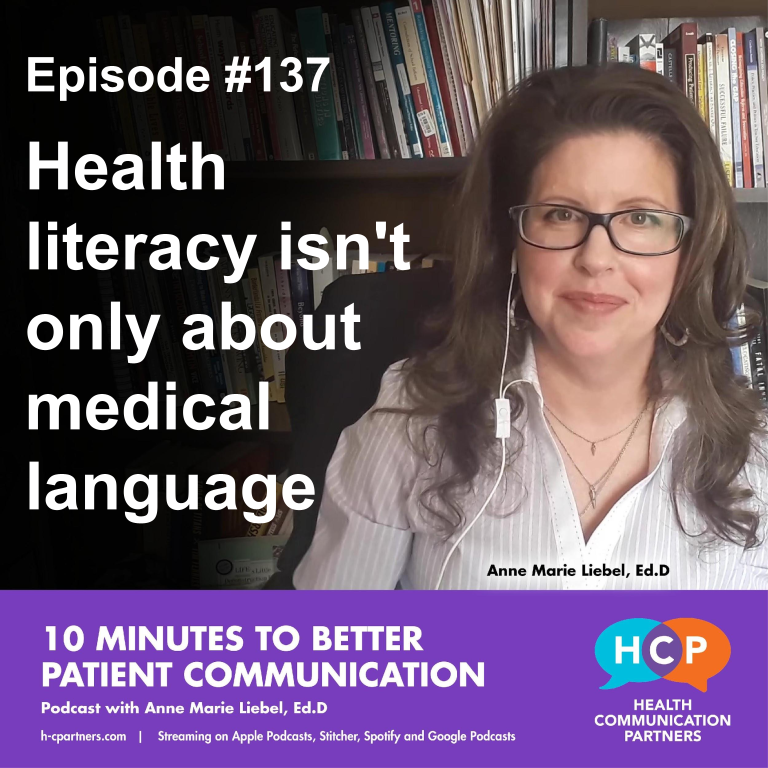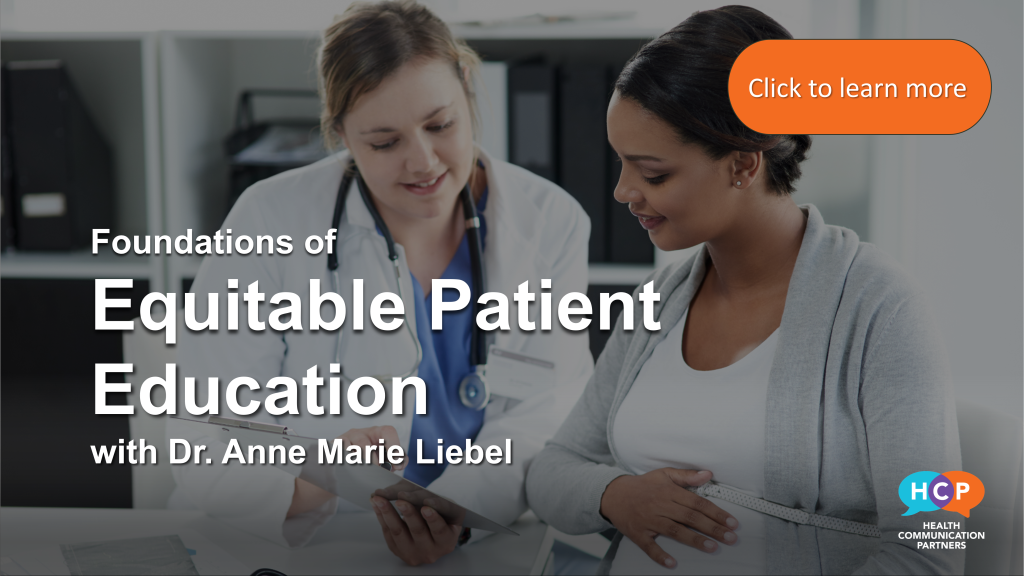A few health professionals recently shared stories of pushback from colleagues regarding health literacy. Learn how you can respond to the next person who believes health literacy is just about medical terms.

In this episode, I take up a problem expressed recently by a few health professionals who were frustrated by some pushback they were receiving when it came to health literacy and patient communication. And as it turns out, their problem might be related to something I was warned about nearly 20 years ago.
Hi everybody. I’m Dr. Anne Marie Liebel and this is “10 Minutes to Better Patient Communication” from Health Communication Partners. Our expertise is in teaching people and organizations how to get better at communication. Our new course teaches all patient-facing employees to identify and manage those cultural mismatches that can show up in communication. Why? Because every interaction with the patient is important, and everyone who interacts with patients deserves high-quality support. So from Cafeteria to Cardiology, we’ve got you covered, with Foundations of Equitable Interpersonal Communication in Health. Learn more at healthcommunicationpartners.com
When health literacy burst on the scene decades ago it brought some needed attention to the disconnects between medical language and people’s everyday language. Now, I wasn’t on the scene when health literacy became a thing. But I understand now that the trend or the tendency in health communication and in science communication more broadly had been to focus on the healthcare worker and what they said, their message. And that’s very important but kind of lopsided. Because if you’re only thinking about one person’s words, that’s a monologue. So there was great rejoicing (I was told) when health literacy came around, because health literacy put the focus on the patient, which is great!
And, yet. Health literacy as a field is still experiencing growing pains, and on-the-ground practitioners are working as hard as ever to communicate well, respectfully, with all patients. Recently, a few health professionals were sharing a challenge they ran into when working on the wording of patient rights and responsibilities. They were getting pushback because, as one person put it, “since there’s little to no health or medical language included, some folks thought there was not a need to make it health literate.”
When I first heard this story, I thought about a talk I was at. It was a health communication conference at Yale University, and it was 2016 or 17. And one of the keynote speakers was Dr. Marcella Nunez-Smith, and she said something that has stuck with me. She said, “health communication is a subset of human communication.” I thought it was a cool thing to say then, but I appreciate it even more now. I think it’s an important framing. I think it’s a reminder.
Those health professionals clearly understood health literacy isn’t just about how we handle medical language. Their implied question was “how do we handle this challenge when it emerges?” And in answering that implied question, I’m going to share something that I have not shared before. I wonder what you’ll make of this.
Now in a recent episode, and on and off throughout this series, I’ve talked about one of my professors, Dr. Brian Street. And he was one of the founders of what’s known as the New Literacy Studies. Back in 2005, Brian saw a trend that he warned us about. And the trend he observed was academics, but also in popular news and communication, putting the word “literacy” behind another term and calling it a thing. “Computer literacy” was a big one. Financial literacy, environmental literacy, health literacy.
Brian’s concern was that putting “literacy” behind a term would artificially limit our focus to a narrow set of skills–computer, Finance, et cetera–and that we’d be getting away from the real actual language that was actually being used. Maybe that’s what’s happened here. Maybe in some places, for some people, health literacy has come to mean something too narrow. As if financial literacy was all about plusses and minuses. Yeah, to keep a bank balance, you need to be able to add and subtract, kind of, I suppose. But there’s a whole lot more.
I’m going to suggest the next time you run into someone who thinks of health literacy as simplifying medical jargon you say “Yes! And…” Yes, it’s important, you know, not to lose people in the jargon. AND, as a health professional, very often you’re communicating about topics other than strictly medical stuff. You have to talk about social and cultural topics, legal topics, financial topics, religious topics, more. That’s what the professionals at the start clearly understood. And if you talk with patients maybe you’ve noticed the lines between these kinds of topics and health topics are blurry. What might happen if health literacy could make sense of this complexity? What would it be like if we conceptualized and acted and researched health literacy in ways that recognized it’s a subset of human communication?
Well I’ve got good news. This work is already happening. It’s been underway for let’s say more than 25 years now and I’m going to tell you about it. To kick this off I’m going to go to a paper that I referenced a few times before in this show from Papen and Walters in 2008. And it’s because I love the way that they put this. They say “another way of looking at health literacy and literacy more generally is to think of it as social practices. As activities which are always imbedded in specific situations and contexts, and whose actual shape and meaning can only be understood within these contexts.”
Earlier, back in 1997, Peter Freebody, who was a contemporary of Brian Street’s and also involved in the New Literacy Studies, and Jill Freiburg wrote about health literacy. And they said they approached “literacy and health as sets of interrelated cultural practices, highly dependent on context, and informed and themselves informing our other sets of knowledge and assumptions.”
Now you communicate with patients and clients about their health. That’s why you listen to this show. You know that people’s emotions come into it. You know timing comes into it. You know money comes into it. You know waho else is in the room comes into it. You know social class comes into it. You know power comes into it. These are social contexts and social phenomena with real effects. Because emotion and time and money and other people and social class and power make a difference to the kind of sense a particular person is making of the words that are being used on them, and a words they’re using.
We know this, but our tools and approaches don’t always accommodate it. And if some folks are hung up on kind of a narrow vision of health literacy they might not see it as a possibility at all. Sometimes we need additional ways to capture what we’re observing. So when you let yourself think about health literacy as a set of social practices, you get to include all these together. The social processes view of literacy has been used in health literacy for decades and I think it’s great for a lot of reasons but one of them is because it gives us a way to include what and who we know makes a difference. And it allows us to include language in use. Not just medical language–all of the language!
A social practices view of health literacy disentangles health literacy from education and intelligence and motivation. And it allows for the complexity we know is there and we want to capture. This is a way of collecting together what you already know about health literacy. So if you want to get started, check out the references I’m putting in the links for the studies that I’ve just mentioned, and get in touch with me on the socials. This has been “10 Minutes to Better Patient Communication” from Health Communication Partners. Audio engineering from Joe Liebel. Music from Joe Liebel and Alexis R.
